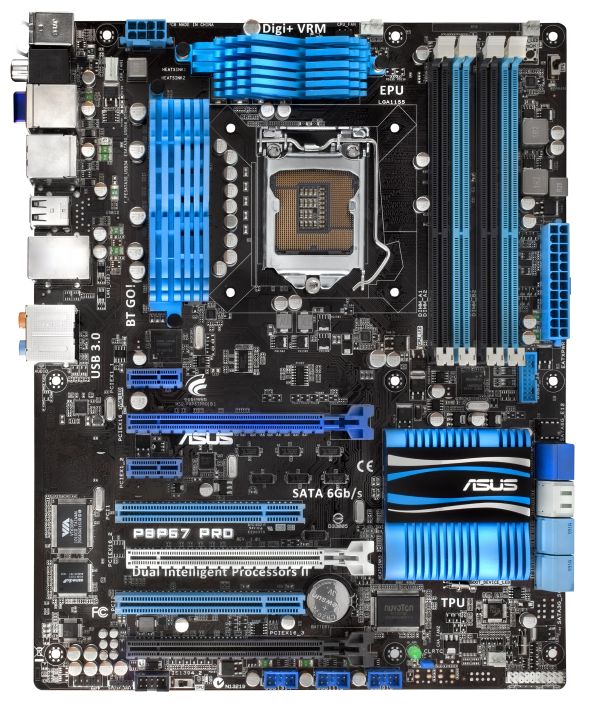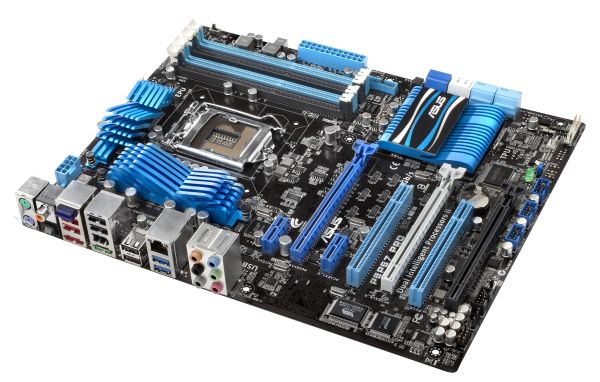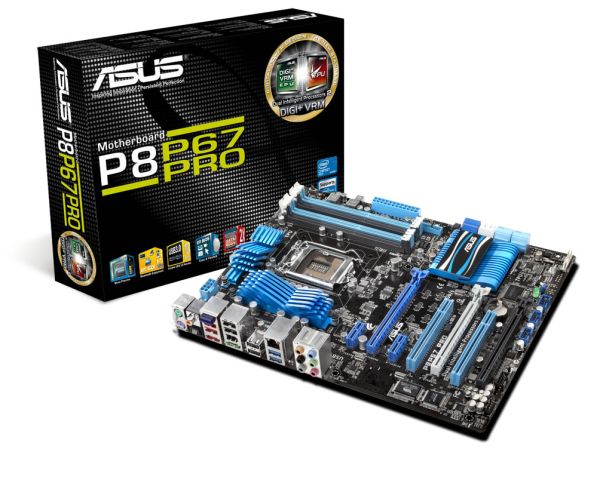The Battle of the P67 Boards - ASUS vs. Gigabyte at $190
by Ian Cutress on January 20, 2011 4:15 PM EST- Posted in
- Motherboards
- Gigabyte
- Asus
- P67
The ASUS P8P67 Pro fits near the beginning of the line-up in the ASUS launch, which in terms of ATX sized boards include the P8P67, the P8P67 Pro, the P8P67 Evo, the P8P67 Deluxe, the Sabertooth P67, the P8P67 WS SuperComputer and the top end Maximus IV Extreme. Therefore, with that in mind, we would expect to be looking at something above the base – slightly more (or better) features than the cheap boards available, enough to warrant the price difference. An overview of the P8P67 series is below:
| P8P67 Series | ||||||
| P8P67 LE | P8P67 | P8P67 PRO | P8P67 EVO | P8P67 Deluxe | ||
| Price | $140 | $160 | $190 | $210 | $235 | |
|
SATA 6 Gb/s SATA 3 Gb/s eSATA |
3 4 1 |
4 4 1 (bracket) |
4 4 2 |
4 4 2 |
4 4 2 |
|
|
CrossFireX SLI |
Yes No |
Yes No |
Yes Yes |
Yes Yes |
Yes Yes |
|
|
USB 3.0 USB 2.0 |
2 14 |
4 (2 via header) 12 |
||||
| LAN | 1 | 1 | 1 | 2 | 2 | |
| Bluetooth | No | Yes | Yes | Yes | Yes | |
Visual Inspection
ASUS have gone with the blue/white/black livery for the Pro board, with a 12+2 digital VRM design covered by slanted blue heat sinks. The socket itself is relatively clear, easily allowing large 1155/1156 CPU coolers to be fitted (remember, 1155 mounting holes are the same as 1156). The CPU fan header is located at roughly one o’clock from the socket itself, with a chassis header to the right of the DIMM slots, presumably for HDD bay type fans.
Next to this header are the EPU switch and the MemOK buttons. The EPU switch enables Energy Processing Unit, which is geared towards saving energy – this encompasses power gating certain features that are never used/used rarely, and declocking when less compute is required. The MemOK button is a physical override for overclocked memory – by holding it down until the red light comes on, at next boot, the UEFI will override the memory settings to something more suitable.
The SATA connectors come in blue (SATA 3 Gb/s), white/grey (SATA 6 Gb/s provided by the chipset) and navy blue (SATA 6 Gb/s provided by a Marvell controller). There is a USB 3.0 header also here, near the DIMM slots. These are all next to the ASUS logo and chipset cooler, which underneath have another chassis header and a green power light. This board is lacking both a debug LED and power/reset buttons on the main board, much to our disappointment.
The PCI slots are well laid out, with a PCIe 1x at the top and enough space between the first two PCIe x16 for a PCI card, meaning that at least one is available if all three PCIe x16 are occupied with dual slot cards. The black PCIe x16 slot is wired up as an x4 slot (as it shares bandwidth with the x1 slots, two USB 3.0 ports and the eSATA ports), and with a dual slot card in there, will cover most of the board USB headers.
The TPU switch is underneath the PCI slots, and performs the same function as the TurboV EVO software in the OS to optimise the system for a decent and stable overclock.
The back panel is standard, with dual PS/2 connectors, SPDIF outputs, USB 2.0 slots, USB 3.0 slots, Firewire, eSATA, audio and Ethernet. The blue module three from the left is the ASUS Bluetooth module, designed to communicate with Bluetooth devices to enhance overclocking or utilise music management. The gigabit Ethernet is handily powered by an Intel chip.














137 Comments
View All Comments
jigglywiggly - Thursday, January 20, 2011 - link
gr8 article and I liked the ending comparison to the asrock board, I'ma get that. Just has so many features.vol7ron - Thursday, January 20, 2011 - link
Can't see getting P67. Waiting on Z67. Hopefully it will be all I ever dreamed ofKaboose - Thursday, January 20, 2011 - link
Z68 they didn't stay with 67 on the "Z" chipset apparently.DanNeely - Friday, January 21, 2011 - link
Possibly since LGA 2011 will also use DMI to connect to the chipset Z68 boards will be sold for both sockets; and presumably some of the more mundane chipsets would be used for server/workstation builds.Etern205 - Friday, January 21, 2011 - link
LGA 2011 will use the X68 which is different than Z68.SB chipsets
Highend: LGA 2011/X68
Mainstream LGA 1155/Z68<--Allows for OCing.
vol7ron - Saturday, January 22, 2011 - link
Yep. It was either a typo or a finger fart :)Still, I'm hoping the processor batches will have improved by then. What I'm hoping for is the CPUs to mature a little bit, to possibly get a little higher BCLK overclock (not looking for much, just closer to the 5Mhz).
DanNeely - Sunday, January 23, 2011 - link
Don't hold your breath. The BCLK limit is most likely due to something on your PCI/PCIEe buses (neither of which are designed for any overclock at all) bombing out; not your CPU.medi01 - Friday, January 21, 2011 - link
Suddenly, paying 150-200$ for a motherboard is OK.After all, it makes Intel CPUs "cheaper".
MrSpadge - Sunday, January 23, 2011 - link
It's been like that for a long time. But personally I never saw the value in expensive motherboards.MrS
medi01 - Monday, January 24, 2011 - link
I don't recall it "being like that" for AMD motherboards.